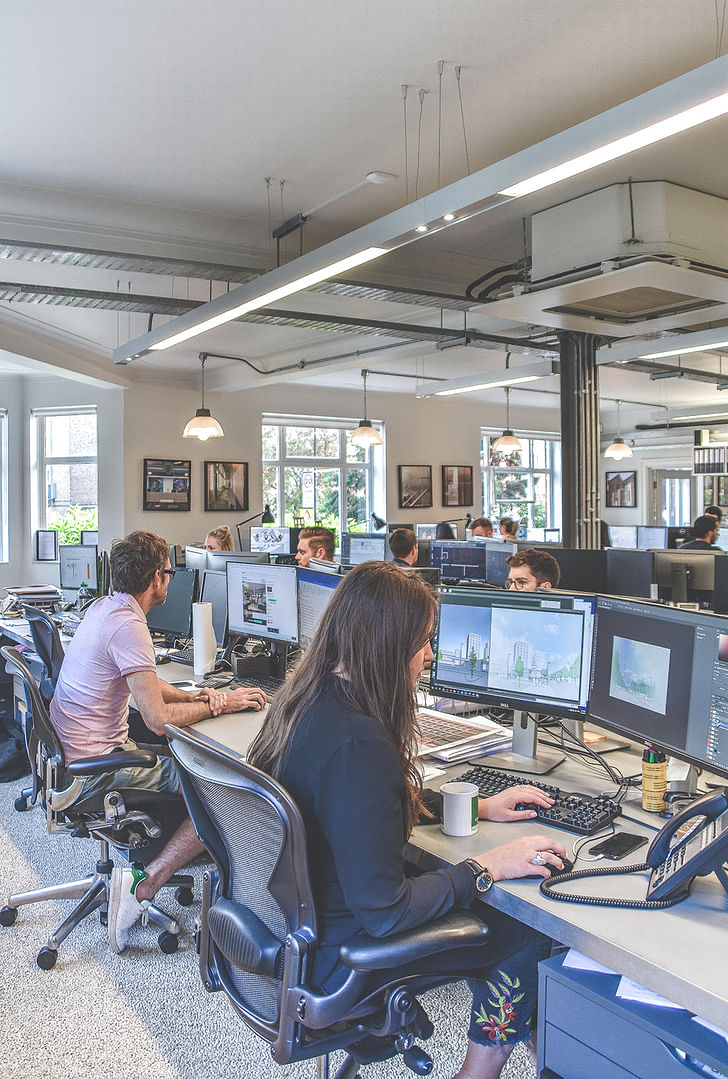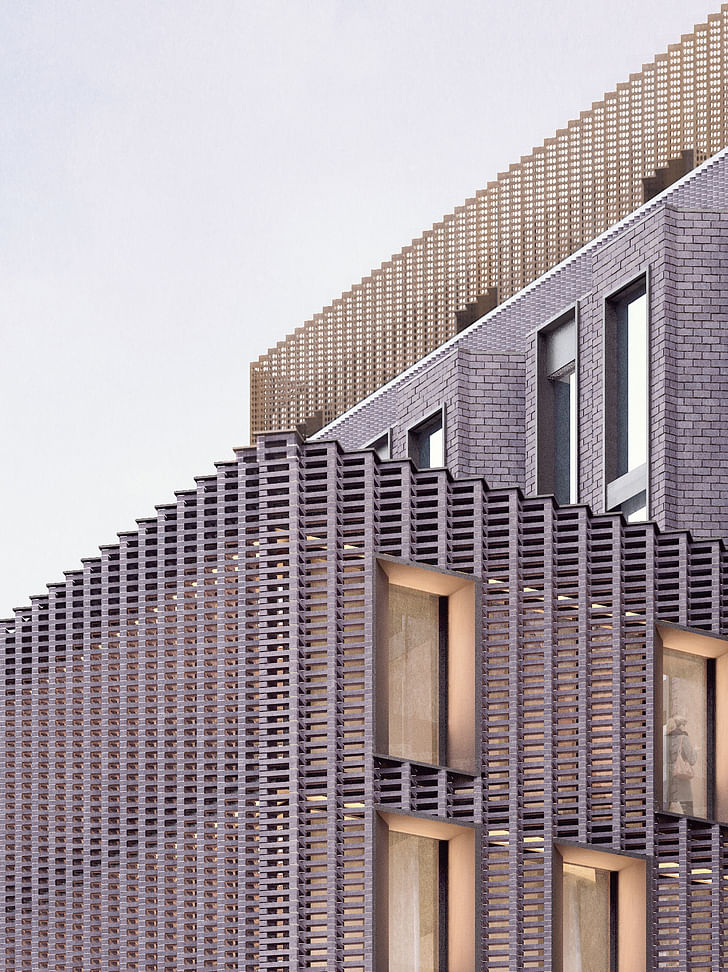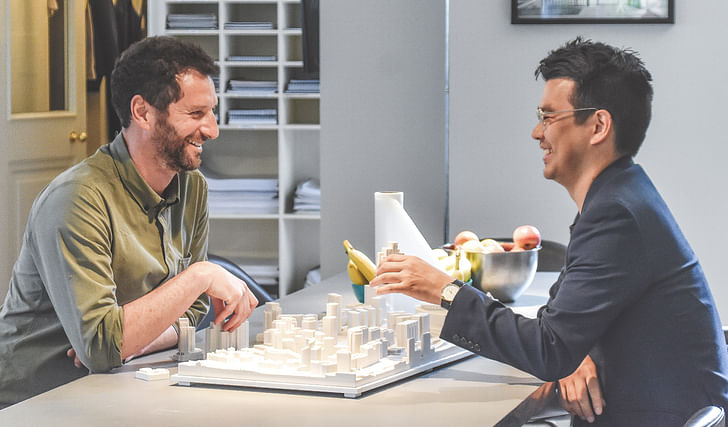

The short walk to dMFK from the tube is a uncommonly green one. Upon arrival Julian, the founding director, showed me the secret communal gardens the studio shares with their residential neighbours which includes several tennis courts, a BBQ and the recent addition of a pizza oven. It is easy to understand why they have called this studio home for so long.
A proudly collaborative studio, (currently they are working with other London based practices Hawkins\Brown and ACME), they are particularly skilled within the heritage and residential sector. I met with the three directors, Julian de Metz, Paul Forbes and Ben Knight to find out more about their approach, current projects, and how they socialise as a team.
Location?
West Hampstead
When did the practice start?
2001
How many staff?
30
Company ethos?
Paul: We are a naturally collaborative and diverse practice. We have a breadth of skills and workload represented by our three varied backgrounds. We try to bring these together into a legible design approach, reinforced by all working together in a single space and constantly being aware of what everyone else is doing.
Ben: The diversity of our workload is reflected in our people - we like all rounders - architects who like to do a bit of everything and who also have a natural way with people. We also try to mix up the layout, putting people just starting next to people with lots of experience, so there is a real cross over.
Julian: We are a design-led practice doing commercial work, but we bring a sense of community to many of our commercial projects. Conversely, we have many community and arts based clients: including Registered Social Landlords and arts organisations such as the Tate Gallery and Royal Opera House. On these projects, we bring a sense of commerciality. The two things work well together; a commercial approach with non-commercial clients and a soulful community approach with commercial clients. All our projects whether housing or offices, arts or heritage projects have a genuine, warm, community feel which comes from this attitude and a desire to make places where people want to be.

Recently you have been collaborating a lot with other practices - how did these collaborations come about?
J: Traditionally, collaborations have arisen because of a particular speciality we have. For example, with Hawkins\Brown our background in historic / existing buildings was relevant - they had a site where there was a lot of housing but a particularly awkward building in the middle of it. In that case, Hawkins\Brown wanted to collaborate so that they could focus on the new build housing while we handled the historic building.
Similarly, we also worked with ACME on a large scheme in Chester. ACME approached us on a predominantly retail led scheme looking for partners who would focus on mixed use residential elements, so that they could focus on the Civic and retail buildings.
We really enjoy working with other practices as we learn loads, and as a mid sized practice, it exposes us to more formal processes, greater levels of consultant expertise, and puts us in more challenging and complex situations.

Current projects?
B: We have a Flatiron like landmark corner building in Kentish Towncurrently in for planning. On-site we have York House, which is flexible workspace with a really out there lattice brick extension designed with Webb Yates, and Brewers Hall, currently in stage four, a 3 storey roof extension and refurbishment of a historic City Livery Hall. We’re also just finishing Butchers’ Hall, which is a refurbishment and extension of another post war livery hall.
J: We are also doing a lot of housing at the moment including a really nice 23 storey tower in Wembley which is now on site. We are also on-site with Nestle, which is over 1400 units, a part of the project we are working on with Makower Architects and Hawkins\Brown.
In addition, we are doing a lot of CAT B flexible workspace, including three floors of the iconic 1 Canada Square linking them together and making a central atrium, and also one in Frankfurt both for The Office Group.
Separately, we are doing quite a lot more analytical and process led projects which I really enjoy. We have an ongoing project for a well known arts organisation which is looking at how they could work more flexibly and collaboratively and involves a more intense and analytical process of brief development, and production of a phased estate strategy.

You work a lot on heritage and existing buildings. What is your approach when trying to harmonising the old and new?
J: We try to develop a solid understanding of the original design, and then to question how relevant that is today. It’s important to us to try to empathise with the original architect, to imagine what they would have done today, and to try to look for the good in a building. That way you can start to evolve the building towards it’s new life.
B: It is quite often a metamorphosis of the original building, because you have to do a lot of analysis into what the original building was, and how it worked before, but also take into account changing programmes. As Julian said, considering all along what the original architect would do, but trying to evolve it in an intelligent way.
J: We really enjoy Grade II Listed and locally Listed buildings in particular - they can accommodate change most readily. For example, the Grade II Listed Salters’ Hall ( by Sir Basil Spence) was approached in a fearless way. We completely changed the way you enter the building through a new building. It now responds to a very different context. Sometimes heritage work appears ‘terrified’. We want to be brave with these buildings and in doing so, flatter their original design.
York House has the same story. A 1980’s building, very unloved, built in very dull engineering brick. The client wanted to extend it and potentially over-clad it. We persuaded them to reuse the original engineering brick, but in a subverted, contemporary way. This is the approach we take with all these renovation projects, trying to look for quality in the original building.
We try to develop a solid understanding of the original design, and then to question how relevant that is today. It’s important to us to try to empathise with the original architect, to imagine what they would have done today, and to try to look for the good in a building.

Favourite part of the studio?
P: My favourite part is the main workspace and the fact that we are all able to work together there. We’ve got quite a conundrum in trying to find a new office as we really wouldn’t be happy being separated in a multi-floor building. Being together is the heart and soul of our business.
J: For me, it’s looking out and seeing greenery and trees and being in a really bright, open space. Also, because our office was previously the library in an old mansion block, we have access to a secluded communal garden which has tennis courts, BBQs and a pizza oven which make it unlike anyone else's space.
Favourite nearby coffee shop/pub?
J: The Czech and Slovak Bar and Restaurant in West Hampstead. It’s very real. Sometimes it’s a bit too real.
B: Yes - It is an authentic 1970’s Czech experience! There is an old TV playing a Czech news channel so loudly you can barely think, and the beer is amazing!

Do you socialise together?
J: We take the whole office away every year on a boating holiday and stay together for three days on a few boats. When dMFK people get together, they get stuck in - cooking, sharing, making things and they know how to have fun.
Back at the office, there’s lots of sport - cycling in particular - and when we get the time we organise tennis tournaments in the gardens behind the office.
B: We also do film nights, poker and informal work reviews in the evening whenever we can.
Most played song/artist/musician in the studio?
J: Steely Dan is heavily played by me and everyone else just has to put up with that. You can’t please everyone so we keep it relaxed, but mainly we prefer people not to wear headphones because as soon as they are, they are unaware of what is going on in the office. Working in one space gives the opportunity to learn by osmosis, how to deal with people and also to hear about other projects.

The National Theatre...as a mirror for society, seeing how values change and how we fundamentally change the way we use spaces it is an extremely fascinating building.
Favourite building in London?
B: Lloyds.
P: The National Theatre because of the evolving public perception of the building and how it has changed through time. I remember roller skating there 40 years ago and when I went this weekend to some of those same spaces they have just completed changed. As a mirror for society, seeing how values change and how we fundamentally change the way we use spaces it is an extremely fascinating building.
J: I really like Alexandra Palace at the moment, because there are so many things going on there and it feels really accessible to the public.

Favourite building you have designed?
J: I think it is a combination for me of Salters Hall, the public realm is really great there, and then York House that we are currently working on.
B: For me, it is Salters Hall - we spent ten years on that project, and invested so much in it and the result is terrific and very satisfying. I think Sir Basil Spence would have approved...
P: I really like West Sussex House which although not built is one of my favourites. People love it and it has a real atmosphere. It was a little foresters cottage that we planned to extend and extrude out, with big lateral slots cut through it. I have now decided that if no client is going to build it, then it is my project. I’ll have to save up and do it for myself.
Ellen Hancock studied Fine Art and History of Art at The University of Leeds and Sculpture at Mimar Sinan Fine Arts University in Istanbul.Now based in London she has a keen interest in travel, literature, interactive art and social architecture.
No Comments
Block this user
Are you sure you want to block this user and hide all related comments throughout the site?
Archinect
This is your first comment on Archinect. Your comment will be visible once approved.